How Art Therapy Helps People with MS Express What Words Can’t
Introduction
When you live with Multiple Sclerosis (MS), you often find yourself struggling to describe what’s happening inside your body and mind. There are moments when words fall short — when fatigue feels deeper than tiredness, or pain feels stranger than anything you can explain.
This is where art therapy steps in.
🖌️ Art therapy is more than painting pretty pictures.
It’s a path to emotional release, healing, and self-expression — especially when MS takes away clarity, speech, or confidence.
In this article, we’ll explore:
- What art therapy really is (and isn’t)
- Why it’s so powerful for people with MS
- How different forms of creative expression support emotional well-being
- What a typical session looks like
- Inspiring stories of MS warriors who found healing through art
- How to get started at home — even if you think you're “not creative”
Let’s uncover the healing that happens beyond words. 💙
Looking for online therapy? Click here.
🖼️ What Is Art Therapy?
Art therapy is a mental health treatment that uses visual arts (like painting, drawing, collage, sculpture) as a tool for emotional expression, self-discovery, and coping.
It’s practiced by licensed art therapists, trained to guide people through the creative process in a therapeutic setting. But it’s also something you can start on your own as a wellness practice.
Art therapy is not about artistic skill. You don’t need to be a painter or even own fancy supplies. All you need is:
- A way to make marks (pens, crayons, paint, markers)
- A safe space to express
- A willingness to explore your inner world
🧠 Why Is Art Therapy Especially Helpful for People with MS?

MS affects the nervous system, but it also touches every corner of life — from your mobility and speech to your self-image and mental health.
Here’s how art therapy can help MS patients:
1. 🎭 Express What Words Cannot
Some MS symptoms — like brain fog, dissociation, anxiety, and fatigue — are hard to describe. Art allows people to show what they’re feeling through shapes, colors, textures, and symbols.
“I drew my fatigue as a heavy gray cloud that pressed me into the floor,” said one MS patient. “It made me cry — but also feel seen.”
2. 😢 Process Trauma and Medical Experiences
MS is often traumatic. The diagnosis, the tests, the unpredictability, the losses… they can leave deep emotional scars.
Art therapy provides a nonverbal outlet for:
- Medical trauma
- Feelings of powerlessness
- Fear of the future
- Anger at your own body
It gently bypasses the “logical” mind and goes straight to the emotional core.
3. 🧘 Reduce Stress and Promote Mindfulness

Creating art can trigger a flow state — where you’re fully present, your breathing slows, and your nervous system calms down. This helps reduce cortisol and ease inflammation.
Many MS patients report that:
- Drawing reduces their pain perception
- Coloring helps them sleep
- Sculpting with clay eases anxiety
4. 💪 Rebuild Identity and Self-Esteem
When MS robs you of your mobility or energy, it can feel like your identity crumbles. You may feel useless or disconnected from the “old you.”
Art helps you rebuild your sense of self.
Even small projects can restore confidence:
- “I can create beauty.”
- “I do have something to say.”
- “I am more than my illness.”
Looking for online therapy? Click here.
5. 🖐️ Improve Fine Motor Skills
Some types of art — like finger painting, soft clay work, or adapted brushes — can be used as occupational therapy to strengthen hands, wrists, and arms.
And because it’s fun and meaningful, people tend to stick with it longer than traditional exercises.
🧰 What Happens in a Typical Art Therapy Session?
A licensed art therapist may work with you one-on-one or in a group. Sessions can happen in person, in clinics, online, or at home.
A session might include:
- A short check-in and guided visualization
- A creative prompt (e.g., “Draw your MS pain,” or “Paint what hope feels like”)
- Time to create without judgment
- Reflection, discussion, or journaling
- Support from the therapist in processing any emotions that come up
You don’t need to explain your art — unless you want to.
The goal is not a masterpiece. The goal is emotional expression and self-awareness.
🎨 Different Types of Art in Therapy
Here are some common forms of art used in MS-friendly therapy settings:
| Art Type | How It Helps |
|---|---|
| Drawing & Sketching | Easy to do anywhere, low barrier |
| Painting | Encourages emotional expression |
| Collage | Great for people with limited mobility |
| Clay or Sculpture | Helps with tactile grounding |
| Mandala-making | Brings calm and focus |
| Mixed Media | Combines elements, fun for experimentation |
Some people even explore photography, digital art, or fiber arts (knitting, weaving) — whatever resonates with them.
🧑🎨 Real Voices: How Art Changed Lives with MS
“I painted a series of faces showing my moods during flares. My therapist helped me see I was grieving. That opened the door to real healing.”
— Clara, 42, RRMS
“My speech got worse during relapses. But in my art journal, I could still ‘talk.’ It became my favorite therapy tool.”
— Daniel, 37, SPMS
“I kept collaging images of birds and wings. I realized it was my way of reclaiming freedom even while using a wheelchair.”
— Mei, 50, PPMS
🏠 How to Try Art Therapy at Home
You don’t need an official art therapist to begin. You can start a healing art practice from your couch, bed, or kitchen table.
💡 Starter Ideas:
Emotion Wheel
Draw a circle. Fill it with colors or symbols that represent your current emotional state.
MS Symptom Creature
Imagine your worst symptom as a character. What color is it? What does it look like? Give it a name. (This helps externalize and reduce fear.)
Hope Collage
Cut out images and words from magazines that symbolize healing, strength, or peace. Glue them together on a poster.
Abstract Pain Mapping
Close your eyes. Use colored pencils to mark where you feel discomfort in your body. Let your hand guide you.
Art Journal
Combine doodles, phrases, and paint splashes in a notebook. Make it a private space to express without rules.
🧡 Tips for a Gentle, Empowering Practice
✨ Let go of perfection — this is for you, not an art show
✍️ Add short reflections if you like journaling
🎶 Play soft music while you create
🕯️ Light a candle or diffuse calming oils to make it a ritual
🧍 Adapt tools if you have tremors or mobility issues (grip aids, large brushes, finger paints)
Remember: Your art doesn’t have to be good. It just has to be real.
🧑⚕️ How to Find a Licensed Art Therapist

If you want guided support, look for a registered art therapist (ATR or ATR-BC) who has experience with chronic illness or disability.
🔍 Where to search:
- ArtTherapy.org (U.S.)
- BAAT.org (UK)
- Psychology Today’s therapist finder (filter by “Art Therapy”)
- Ask your neurologist or MS support groups for referrals
- MS Society chapters may offer local or virtual groups
Some therapists offer telehealth sessions, which are great for low-energy days.
🌈 Final Thoughts: You Deserve to Express Yourself
Living with MS means living with loss, adaptation, and courage. But it also means living with creativity, resilience, and soul.
Art therapy gives you a place to say:
- “I am still here.”
- “I matter.”
- “My experience deserves to be seen.”
Whether it’s a scribble, a sculpture, or a collage of magazine clippings — your art can be a mirror, a voice, and a friend.
So pick up a pen. Smudge the paint. Let the colors speak for you.
You’ve been carrying so much.
Now let it out.
Looking for online therapy? Click here.
Related Posts
-

Learning to Feel Safe in Your Body Again
If your body no longer feels like a safe place—due to trauma, chronic illness, or anxiety—you’re not alone. This guide offers gentle, body-based strategies to help you reconnect with yourself, regulate your nervous system, and rebuild trust in your physical experience.
-

When You Feel Emotionally Unlovable: Challenging the Lie
Feeling unlovable because of your emotions, illness, or sensitivity? You’re not broken—you’re healing. Learn how to challenge the lie of emotional unworthiness and rebuild self-trust, one compassionate step at a time.
-

Brain Fog and Fatigue: How to Stop Blaming Yourself
Struggling with brain fog or chronic fatigue? You’re not lazy or failing. Learn how to stop blaming yourself for symptoms caused by MS or chronic illness, and start embracing a more compassionate path to healing and self-understanding.
-

Creating an Emotional Support Team You Actually Trust
Tired of feeling unsupported or misunderstood? Learn how to build an emotional support team you actually trust—with people who see you, hold space for you, and respect your boundaries, especially when living with MS or chronic illness.
-

MS, Vulnerability, and the Fear of Being Seen
Living with MS can make vulnerability feel unsafe. Learn why so many people with MS hide their struggles—and how to gently move toward authenticity, self-acceptance, and deeper connection without shame.
-
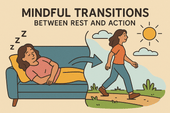
Mindful Transitions Between Rest and Action
Struggling to shift between rest and activity without guilt or overwhelm? This guide offers gentle, mindful strategies to make transitions feel more natural, intentional, and supportive of your nervous system.
-
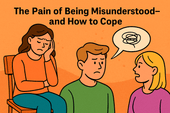
The Pain of Being Misunderstood—And How to Cope
Feeling the sting of being misunderstood? Learn why it hurts so deeply and discover practical, healing strategies to protect your truth, communicate clearly, and rebuild emotional safety when others just don’t get it.
-

Letting Go of Productivity Guilt When You Need to Rest
Struggling with guilt every time you try to rest? Learn how to release productivity shame, understand why rest matters, and embrace a more compassionate rhythm for healing and recovery—without feeling lazy.
-

Rebuilding Energy Reserves Without Shame
-

What to Do If You Feel Emotionally Invalidated by Doctors
Feeling emotionally invalidated by your doctor can be deeply distressing. Learn how to recognize medical gaslighting, validate your own experience, and advocate for better care when you’re not being heard.
-

How to Rest Without Feeling Lazy
Rest isn’t laziness—it’s a necessary act of self-respect. Learn how to shift your mindset, let go of guilt, and embrace rest as a vital part of mental and physical well-being.
-

Redefining Energy Management as Emotional Self-Care
Energy isn’t just physical—it’s emotional. Learn how redefining energy management as emotional self-care can help you protect your peace, support your nervous system, and live more in tune with your true needs.
-
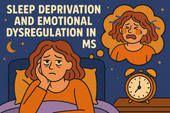
Sleep Deprivation and Emotional Dysregulation in MS
-

How to Cope When Friends Disappear After Diagnosis
Losing friends after a diagnosis can feel like another kind of grief. Discover why some friends disappear—and how to cope with the emotional fallout while building more supportive relationships.
-
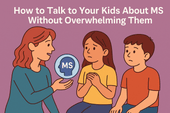
How to Talk to Your Kids About MS Without Overwhelming Them
Struggling with how to explain MS to your kids? Learn how to talk to children of all ages about multiple sclerosis with honesty, clarity, and emotional safety—without overwhelming them.
-

MS and the Fear of Emotional Abandonment
The fear of emotional abandonment is common for people with MS. This article explores why it happens, how it impacts your relationships, and how to create emotional safety and healing.
-

Forgiveness, Closure, and Letting Go of the Past with MS
Living with MS often brings emotional wounds from the past. Learn how forgiveness, closure, and letting go can help you heal emotionally—and reclaim peace in the present.
-

Supplements and Habits That Support Sleep and Emotional Balance
Struggling with poor sleep and emotional ups and downs? Discover calming supplements and daily habits that support deep rest and mental well-being—backed by science and easy to implement.
-

When Insomnia Feels Like Your MS Brain Won’t Turn Off
Struggling to sleep with MS? When your brain won’t shut off at night, insomnia feels relentless. Learn what causes it—and discover science-backed strategies to calm your mind and finally rest.
-

The Emotional Toll of Waking Up Tired Every Day: Why It Hurts More Than You Think
Waking up tired every day takes a deep emotional toll—from mood swings to lost motivation and self-doubt. Learn why chronic fatigue hurts more than you think and how to gently reclaim your mornings.
-
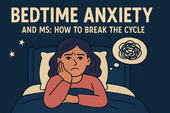
Bedtime Anxiety and MS: How to Break the Cycle
Bedtime anxiety is a common struggle for people with MS—and it’s more than just racing thoughts. Learn how MS-related stress, nervous system dysregulation, and fear of symptoms can create a cycle of sleeplessness, and discover practical, calming strategies to finally reclaim restful nights.
-

How Mental Health Affects Sleep Quality in MS: Breaking the Cycle of Fatigue and Emotional Distress
Struggling to sleep when you have MS? Discover how anxiety, depression, and neurological changes impact your rest—and what you can do to reclaim it. From CBT-I and calming supplements to lifestyle tips that support both mental health and sleep, this guide offers practical strategies for better nights.
-

Learning to Love Your Life (Even When It’s Not What You Expected)
Your life may not look how you imagined—but it’s still worth loving. Learn how to find peace, purpose, and joy in the unexpected.
-

Tips for Managing Depressive Thoughts Without Judgment
Learn how to meet depressive thoughts with compassion, not shame. These gentle, research-backed tools help you manage low moods without self-judgment.
-

Rewiring Hope: How to Slowly Come Back to Life
Feeling emotionally numb or disconnected? Learn how to gently rebuild hope, one small sensory step and spark of life at a time.
-

Depression and Suicidality in MS: A Conversation That Needs to Happen
Depression and suicidality in MS are real—and urgent. Learn why we must talk about it, how to spot warning signs, and where to find help and hope.
-

Finding Meaning When Life Feels Empty
Feeling disconnected or numb? Discover gentle ways to find meaning again—even in emptiness—through daily rituals, reflection, and purpose.
-
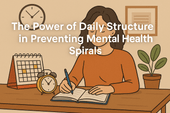
The Power of Daily Structure in Preventing Mental Health Spirals
Daily structure can prevent mental health spirals by creating safety, routine, and self-trust—especially for those with MS, depression, or anxiety.
-

Healing from Emotional Flatness with Sensory Rituals
Feeling emotionally numb or disconnected? Discover how sensory rituals can gently restore pleasure, presence, and emotional resilience.
-

The Role of Light Therapy for Seasonal Depression and MS
Can light therapy ease seasonal depression in people with MS? Discover the science, benefits, and how to use it safely for better mood and energy.
-

Medication vs Therapy: Treating MS-Related Depression Effectively
Explore whether therapy, medication, or both are best for treating MS-related depression. Understand what works, when—and why combination care is often ideal.
-

How to Support a Partner with MS and Depression
Learn how to support a partner living with MS and depression—practical tips, emotional tools, and ways to protect your own mental health too.
-

The Emotional Cost of Losing Your Old Life
Losing your old life to MS isn’t just about physical symptoms—it’s about grieving the identity, dreams, and freedom you once had. This article explores the emotional toll of invisible grief and how to begin healing without denying the pain.
-

MS, Depression, and Hormones: What You Should Know
MS-related depression isn’t always just emotional—it can be hormonal. Discover how thyroid, sex, and stress hormones influence mood in MS, why women may feel worse during PMS or menopause, and what signs to look for when hormones may be driving emotional instability.
-

MS and Anhedonia: Reclaiming Pleasure One Step at a Time
Anhedonia—feeling emotionally flat or disconnected—is a common but misunderstood symptom of MS depression. This article explores how neuroinflammation, dopamine disruption, and fatigue can dull your sense of joy—and how small, gentle steps can help you begin to feel again.
-
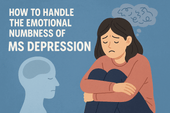
How to Handle the Emotional Numbness of MS Depression
Emotional numbness in MS depression doesn’t always look like sadness—it can feel like nothing at all. Learn why this disconnection happens, how it's tied to neuroinflammation and nervous system overload, and discover science-backed strategies to gently reconnect with your emotions.
-

How Inflammation Can Affect Mood in MS
Mood swings and emotional numbness in MS aren’t just psychological—they can be driven by immune system inflammation. This article explores how inflammatory cytokines affect the brain, why mood changes are often biological, and what you can do to calm your nervous system from the inside out.
-

Recognizing Depression in MS: It's Not Just Sadness
Depression in multiple sclerosis (MS) is more than just sadness—it can be a neurological symptom, a side effect of inflammation, or a silent weight that masks itself as fatigue or emotional numbness. This article helps you recognize the hidden signs of MS-related depression, understand the science behind it, and explore real treatment options that support both mental and physical health.
-

Is Cryotherapy Safe for MS? Pros, Cons, and How It Compares to Cold Plunges
Cryotherapy promises quick recovery, inflammation reduction, and mood support—but is it safe for people with MS? This article breaks down the science, risks, and real-life benefits of cryotherapy for multiple sclerosis. You’ll also learn how it compares to cold plunges and which option may be better for calming flares and regulating your nervous system.
-

Can Cold Plunges Help Reduce Inflammatory Flares in MS?
Flares in multiple sclerosis (MS) are often driven by inflammation—but what if cold water could help turn down the heat? This in-depth article explores how cold plunges may help reduce flare frequency and intensity in MS by calming the immune system, lowering pro-inflammatory cytokines, and regulating the nervous system. Learn how to safely use cold exposure as part of your MS recovery routine.
-

How Cold Exposure May Help Regulate MS-Related Mood Swings
Mood swings are a common but overlooked challenge in multiple sclerosis (MS). This article explores how cold exposure—like cold plunges and showers—may help regulate emotional ups and downs by calming the nervous system, reducing inflammation, and boosting mood-enhancing chemicals. Learn how to use this natural tool safely to support your mental and emotional resilience with MS.
-

MS Fatigue Toolkit: Why Cold Plunges Deserve a Spot in Your Daily Routine
Fatigue is one of the most debilitating symptoms of multiple sclerosis (MS)—often invisible, misunderstood, and overwhelming. While no single tool can eliminate it, building a personalized fatigue management toolkit can make life more manageable. One surprising contender? Cold plunges. In this article, we explore why cold water immersion might be the refresh button your nervous system needs—and how to safely make it part of your MS fatigue routine.
-

Cold Therapy vs. Heat Therapy for MS: Which One Helps More?
Managing multiple sclerosis (MS) often means navigating symptoms like fatigue, spasticity, pain, and nerve dysfunction. But when it comes to using temperature-based therapies, there’s a question many patients face: Should I be using cold or heat? In this in-depth guide, we explore the benefits, risks, and best use cases of cold therapy vs. heat therapy for MS.
-

From the Tub to the Brain: How Cold Plunges Might Support Cognitive Clarity in MS
Cognitive fog is one of the most frustrating symptoms of multiple sclerosis (MS). But could cold plunges—those bracing dips into icy water—offer a surprising path to mental clarity? This article explores the emerging science behind cold exposure, brain function, and how a cold tub might help people with MS sharpen focus, lift brain fog, and reset their nervous system.
-

Why MS Patients Are Turning to Cold Plunges for Relief and Resilience
Cold plunges are no longer just for elite athletes and wellness influencers. A growing number of people with multiple sclerosis (MS) are turning to cold water immersion to ease symptoms, build nervous system resilience, and find calm in the chaos of chronic illness. This article explores why—and how—you might want to give it a try.
-

Cold Plunge Therapy: A Hidden Gem for People with MS?
Cold plunge therapy—once the domain of elite athletes and biohackers—is gaining attention among people with multiple sclerosis (MS). Could it help reduce inflammation, calm the nervous system, and ease MS symptoms like fatigue and spasticity? In this article, we dive deep into the science, benefits, safety, and practical application of cold plunges for MS recovery and symptom relief.
-
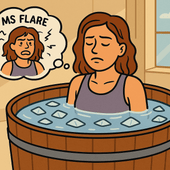
Finding Relief in the Midst of a Flare
MS flares can leave you feeling overwhelmed, exhausted, and mentally foggy. Cold water therapy is emerging as a promising tool to help reset the body and mind after a flare. This article explores how cold exposure supports recovery, calms the nervous system, and can be safely added to your daily routine.
-

How Cold Exposure May Help Regulate MS-Related Mood Swings
Mood swings in multiple sclerosis (MS) can feel like emotional whiplash—one moment calm, the next overwhelmed, angry, or hopeless. While medications and therapy help, many people with MS are exploring natural strategies to support emotional balance. One surprising tool gaining attention? Cold exposure. In this article, we explore how cold plunges and other forms of cold therapy may regulate the nervous system, stabilize mood, and offer emotional relief for people with MS.
-

How to Build an At-Home MS Recovery Corner (with Cold Plunge Setup)
Create your personal MS recovery oasis at home—complete with a cold plunge setup. Learn how to design a space that supports healing, reduces inflammation, and helps you manage symptoms naturally.
-

The Role of Temperature Regulation in MS: Why Cooling Matters


















































